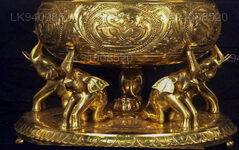
Sri Lanka
Sri Lanka, an island nation in South Asia, is renowned for its rich cultural heritage, diverse landscapes, and wildlife. Attractions include ancient temples, pristine beaches, lush tea plantations, and vibrant festivals. The country's unique blend of cultures, warm hospitality, and delicious cuisine make it a captivating destination for travelers.
Brassware
More than any other metal, brass adds a shine to a Sri Lankan home. Every Sri Lankan family owns a collection of traditional brassware, often a treasured heirloom passed down from generations. Central to the collection is the ornamental brass lamp,used to inaugurate almost every special function and ceremony. No Sri Lankan home is complete without one. Sri Lankans believe that lighting an oil lamp brings luck, and what better lamp to light than one made of ornate gleaming golden brass. Sri Lanka's brassware industry, now very much a part of the country's culture and national crafts, is widely believed to be a colonial Dutch import, although it is also possible that it arrived from the Indian subcontinent or was brought by the Arab traders who first visited the island. A thriving brass industry has existed across India from ancient times, while brassware was said to have been produced in the Middle East as far back as the fourth Century BC.
Nevertheless, the country has a long history of metal work, with archaeological finds of smelting furnaces dating from the earliest times of human habitation on the island. The island is well known for its steel and copper crafts, said to have been so highly developed in ancient times, that the country was exporting steel to Damascus. Archeological findings of steel and copper surgical instruments have been discovered in the east central region, especially in the ancient city of Polonnaruwa. Bronze, which arrived in the eighth Century, also took firm root in the island. Nevertheless, there is no mention of brass products in ancient times. The village of Angulmaduwa, seven kilometres from Beliatta in the southern district of Hambantota, is said to have birthed the country's first brassware. Famed for its skilled metal artisans, Angulmaduwa is said to have begun producing brass products after the Dutch occupation in the 17th Century. The Dutch wanted brass items for their horse-drawn carriages and so these artisans met the need. Brass, an alloy of copper and zinc, is malleable. By varying the proportion of the two ingredients, a range of brass of different colours can be produced, of which golden yellow brass is the most popular in Sri Lanka.
Soon ornamental brassware began to make an appearance in the country and a tradition was born. The brass craftsmen of Angulmaduwa began to carry their wares to Dondra Head to sell near the temple during the crowded EsalaPerahera period in July-August. As fame of their products spread, one young artisan was invited by the chief monk of the famed Asgiriya Temple in Kandy to settle down in Kiriwaula, a small village in central Sri Lanka near Kandy to practice his trade there. Legend has it that when the talented artisan did not return home,his brother went to the hill capital in search of him.
He found him in Kiriwaula. The brother too settled down there, and the village gradually transformed into a centre of brass crafting. The silversmiths and bronze artisans in the district soon began to work with brass, turning out beautiful traditional brassware bearing exquisite Kandyan motifs, giving the country's ornamental brassware a unique cultural identity. Today, the brass industry is widespread throughout the country, though concentrated in the central hills and to a lesser degree in the south. Angulmaduwa is home to a number of brass workshops, where the artisans manufacture brass using the ancient lost wax method, which though labour-and time-intensive produces exceptionally fine detail. Their counterparts in Kiriwaula use the sand-casting method, which is speedier than lost wax casting. The family who created the brass fence posts enclosing the Bodhi tree of the KelaniyaMahaVihara are from Kiriwaula. Work is more than a trade for these master artisans who often view it as a part of their spiritual practice. Deeply superstitious, they make sure the crucible, called 'cova' in Sinhala, is placed on the surface at an auspicious time. Their women are asked to stay away from the vessel when it is placed on the fire, and also keep silent because the sound of the female voice is said to affect the process. When they receive a big order, the craftsmen make a vow to the gods, usually the god of crafts, God Vishwakarma, that if production is successful, they will either make a brass offering to the gods or make a pilgrimage to the Bodhi tree in Anuradhapura. In modern times, crafts associations and government institutes have boosted the brass industry, through the introduction of modern designs and quality control.
The choice of brassware available today is wide and varied, and includes oil lamps, trays, bowls, vases, betel holders, jewellery boxes, letter openers, bottle openers and candle holders. Brass articles are sometimes plated with silver and other metals or anodised to prevent tarnishing. The proximity of Kiriwaula to famous tourist sites like the AmbekkeDevale and the historical Gadaladeniya temple make it easily accessible. Developmental work in the south will give visitors better access to more remote villages like Angulmaduwa, boosting the industry and incentive to further develop their craft.










